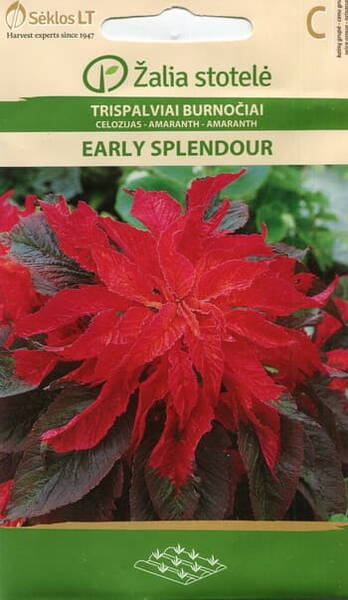A spectacular plant for true aesthetes.
Quickly forms an upright bush up to 50 cm high.
Large leaves, decoratively painted in noble shades of burgundy. Flowers are dark purple (nondescript).
Prefers sunny, wind-protected areas with fertile and sufficiently moist soil. Recommended for group plantings, as well as a background plant. Amaranth perfectly decorates fences and buildings.
Grown by seedlings: seeds are sown shallowly and covered with glass.
Shoots appear quickly, and at the end of May, when the threat of frost has passed, young plants are planted in open ground at a distance of 25-30 cm.
Location: light-, moisture- and heat-loving, fast-growing plants that do not tolerate frost.
Soil: prefers light, nutritious soils with sufficient lime content. Does not tolerate waterlogging and high soil acidity.
Care: 2 weeks after planting, it is advisable to feed the seedlings with a complete complex fertilizer or a mullein solution. Amaranth is drought-resistant. Watering is required only during the period of seedling survival and during prolonged drought.
Reproduction: by seeds, which are sown in mid-May in open ground in a permanent place, followed by thinning to 35-50 cm between plants, or in April in a greenhouse, where shoots appear in 4-5 days (in open ground in 12-20 days). Amaranth seeds are sown shallowly - 3 cm, and the soil surface must be carefully leveled. The seeds do not germinate at soil temperatures below 14 ° C. After the first picking of seedlings into the soil of a warm greenhouse, the plants are planted in separate peat-humus pots, in which they are planted in a permanent place. Amaranths produce seeds well, however, the varieties, being cross-pollinators, heavily cross-pollinate with each other and with wild species. In addition, these plants can self-seed, often of low varietal quality, especially in the southern regions. This should be borne in mind when growing amaranth seeds.
Use: Amaranth inflorescences appear already in late June - early July, and then continue to grow until the end of summer. This is especially noticeable in amaranth tailed, the inflorescences of which become so long by autumn that they partially lie on the ground. These plants are decorative until the onset of cold weather, the first frosts kill them.
Amaranth is used quite widely in floriculture. Low varieties can be used to make beautiful borders and flower beds, use them in mixborders or flower beds. High varieties and species make beautiful high borders and hedges, which can be used to decorate walls or fences. Groups or single plants look good in the center of flower beds, against the background of lawns and shrubs. Low-growing varieties of paniculate amaranth are suitable for growing in containers.
Amaranth inflorescences are an excellent material for drying. To do this, cut off the entire plant, or the inflorescence with part of the stem of the desired length. Leaves are removed from the stem, and the plants are hung upside down in a dry, darkened room. Amaranths dry for quite a long time. During drying, you need to ensure that mold does not appear on the inflorescences due to high humidity. It is better to store them in a dark, dry place, and place compositions with it away from light sources, since the color of the inflorescences quickly fades.











